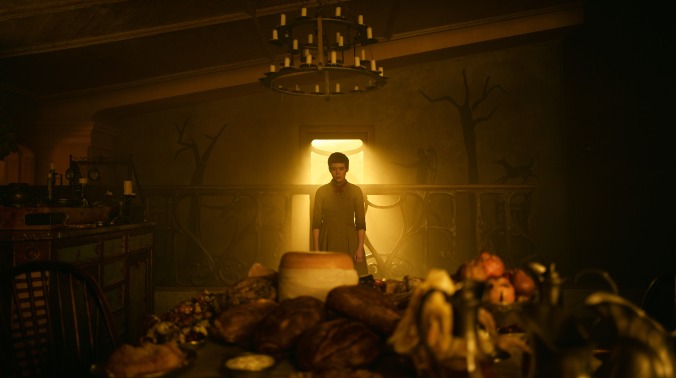Gretel And Hansel comes from Oz Perkins, the cult director who’s made a name for himself on the strength of two films, The Blackcoat’s Daughter and I Am The Pretty Thing That Lives In The House. This is Perkins’ first film to receive a wide theatrical release, and so perhaps it’s to be expected that it would also be his most commercial one to date. Sort of. Though it moves at a much brisker clip, “commercial” is a relative term for a film where the camera lingers on a character pulling a lengthy tress of child’s hair from the back of her throat. The balance Perkins strikes in Gretel And Hansel is reminiscent of another contemporary arthouse horror director, Robert Eggers, whose films aren’t impossibly dense but are too slow for a decent chunk of the horror audience. In fact, screenwriter Rob Hayes borrows a favorite technique of Eggers’, employing stylized dialogue that takes a few minutes to get used to but eventually helps the viewer sink into the film’s world.
It and Sharp Objects’ Sophia Lillis stars as a teenage Gretel, whose name is put in front of her brother’s in the title for reasons that become clear later on. As the film opens, Gretel is looking for work as a servant, and nearly takes a job with a foppish landowner in makeup and sock garters until he asks her if her “maidenhead” is intact. This is the first of a handful of nods to the dangers of moving through the world in a female body, a theme that’s handled surprisingly well considering the film has both a male director and a male screenwriter. It’s also important to what happens after Gretel and her little brother, Hansel (Sammy Leakey), are sent away by their mother, who’s both unwilling and unable to feed them any longer. As in the fairy tale, they fall into the clutches of a sinister witch after nearly starving to death in the woods. But this witch (Alice Krige) lives in a wooden house instead of one made out of gingerbread and gumdrops. She also shows a special interest in Gretel, who seems to have an inborn talent for magic.
This addition to the story allows Gretel And Hansel to explore richer territory than a straightforward fairy tale adaptation, while also leading it to a conclusion that’s almost as predictable as one. Much of this plodding quality is a result of the voice-over that bookends the film, which isn’t quite Blade Runner bad in terms of over-explaining the plot, but it’s in the same ballpark. It doesn’t entirely break the spell of the film’s carefully constructed atmosphere, but it does threaten to, as does Perkins’ choice to have the actors speak in a variety of accents. These are relatively minor considerations, though, and although Gretel And Hansel never makes it to pulse-pounding terror, it does sustain its eerie tone long and well enough that the cumulative effect is hypnotic. The sound effects are also boldly applied, as is the ambient score from French composer ROB, whose use of a mellotron gives this soundtrack a warmer feel than his score for Coralie Fargeat’s Revenge.
As you might expect based on Perkins’ other movies, Gretel And Hansel’s strongest asset is its unique and evocative style, heavy on geometric patterns and glowing orange candlelight. This is not supposed to be any real place at any real time: “Is it not there?” Hansel asks his sister when they first see the witch’s house. “It isn’t. And neither are we,” she replies. This is a fairy tale within a fairy tale, and both the film’s costuming and production design take traditional European styles and add striking modern touches, like the solid black hood that covers one enchantress’ face under her wide-brimmed black hat. Some of this imagery feels legitimately edgy for a PG-13 mainstream theatrical release, like the scene where a witch lays out a feast of human organs as a satanic shadow of the nightly banquet Gretel and Hansel enjoy with their new guardian. So if one of the boundaries being tested in this film is viewers’ patience, the reward for—to use a refrain repeated throughout the film—“trusting the darkness” is well worth the commitment.



 Keep scrolling for more great stories from A.V. Club.
Keep scrolling for more great stories from A.V. Club.